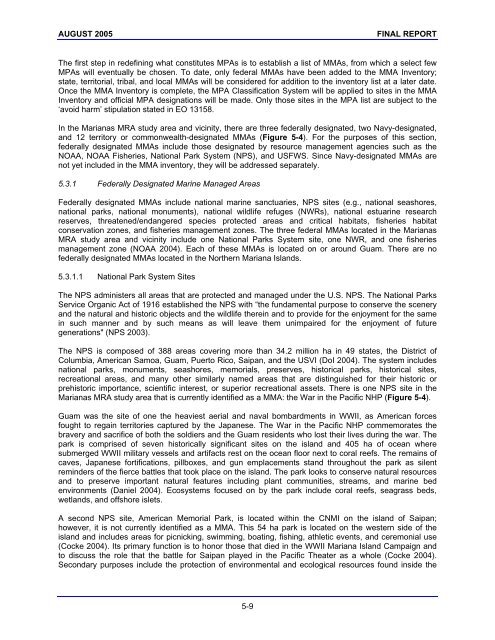Marine Resources Assessment for the Marianas Operating ... - SPREP
Marine Resources Assessment for the Marianas Operating ... - SPREP
Marine Resources Assessment for the Marianas Operating ... - SPREP
You also want an ePaper? Increase the reach of your titles
YUMPU automatically turns print PDFs into web optimized ePapers that Google loves.
AUGUST 2005 FINAL REPORT<br />
The first step in redefining what constitutes MPAs is to establish a list of MMAs, from which a select few<br />
MPAs will eventually be chosen. To date, only federal MMAs have been added to <strong>the</strong> MMA Inventory;<br />
state, territorial, tribal, and local MMAs will be considered <strong>for</strong> addition to <strong>the</strong> inventory list at a later date.<br />
Once <strong>the</strong> MMA Inventory is complete, <strong>the</strong> MPA Classification System will be applied to sites in <strong>the</strong> MMA<br />
Inventory and official MPA designations will be made. Only those sites in <strong>the</strong> MPA list are subject to <strong>the</strong><br />
‘avoid harm’ stipulation stated in EO 13158.<br />
In <strong>the</strong> <strong>Marianas</strong> MRA study area and vicinity, <strong>the</strong>re are three federally designated, two Navy-designated,<br />
and 12 territory or commonwealth-designated MMAs (Figure 5-4). For <strong>the</strong> purposes of this section,<br />
federally designated MMAs include those designated by resource management agencies such as <strong>the</strong><br />
NOAA, NOAA Fisheries, National Park System (NPS), and USFWS. Since Navy-designated MMAs are<br />
not yet included in <strong>the</strong> MMA inventory, <strong>the</strong>y will be addressed separately.<br />
5.3.1 Federally Designated <strong>Marine</strong> Managed Areas<br />
Federally designated MMAs include national marine sanctuaries, NPS sites (e.g., national seashores,<br />
national parks, national monuments), national wildlife refuges (NWRs), national estuarine research<br />
reserves, threatened/endangered species protected areas and critical habitats, fisheries habitat<br />
conservation zones, and fisheries management zones. The three federal MMAs located in <strong>the</strong> <strong>Marianas</strong><br />
MRA study area and vicinity include one National Parks System site, one NWR, and one fisheries<br />
management zone (NOAA 2004). Each of <strong>the</strong>se MMAs is located on or around Guam. There are no<br />
federally designated MMAs located in <strong>the</strong> Nor<strong>the</strong>rn Mariana Islands.<br />
5.3.1.1 National Park System Sites<br />
The NPS administers all areas that are protected and managed under <strong>the</strong> U.S. NPS. The National Parks<br />
Service Organic Act of 1916 established <strong>the</strong> NPS with “<strong>the</strong> fundamental purpose to conserve <strong>the</strong> scenery<br />
and <strong>the</strong> natural and historic objects and <strong>the</strong> wildlife <strong>the</strong>rein and to provide <strong>for</strong> <strong>the</strong> enjoyment <strong>for</strong> <strong>the</strong> same<br />
in such manner and by such means as will leave <strong>the</strong>m unimpaired <strong>for</strong> <strong>the</strong> enjoyment of future<br />
generations" (NPS 2003).<br />
The NPS is composed of 388 areas covering more than 34.2 million ha in 49 states, <strong>the</strong> District of<br />
Columbia, American Samoa, Guam, Puerto Rico, Saipan, and <strong>the</strong> USVI (DoI 2004). The system includes<br />
national parks, monuments, seashores, memorials, preserves, historical parks, historical sites,<br />
recreational areas, and many o<strong>the</strong>r similarly named areas that are distinguished <strong>for</strong> <strong>the</strong>ir historic or<br />
prehistoric importance, scientific interest, or superior recreational assets. There is one NPS site in <strong>the</strong><br />
<strong>Marianas</strong> MRA study area that is currently identified as a MMA: <strong>the</strong> War in <strong>the</strong> Pacific NHP (Figure 5-4).<br />
Guam was <strong>the</strong> site of one <strong>the</strong> heaviest aerial and naval bombardments in WWII, as American <strong>for</strong>ces<br />
fought to regain territories captured by <strong>the</strong> Japanese. The War in <strong>the</strong> Pacific NHP commemorates <strong>the</strong><br />
bravery and sacrifice of both <strong>the</strong> soldiers and <strong>the</strong> Guam residents who lost <strong>the</strong>ir lives during <strong>the</strong> war. The<br />
park is comprised of seven historically significant sites on <strong>the</strong> island and 405 ha of ocean where<br />
submerged WWII military vessels and artifacts rest on <strong>the</strong> ocean floor next to coral reefs. The remains of<br />
caves, Japanese <strong>for</strong>tifications, pillboxes, and gun emplacements stand throughout <strong>the</strong> park as silent<br />
reminders of <strong>the</strong> fierce battles that took place on <strong>the</strong> island. The park looks to conserve natural resources<br />
and to preserve important natural features including plant communities, streams, and marine bed<br />
environments (Daniel 2004). Ecosystems focused on by <strong>the</strong> park include coral reefs, seagrass beds,<br />
wetlands, and offshore islets.<br />
A second NPS site, American Memorial Park, is located within <strong>the</strong> CNMI on <strong>the</strong> island of Saipan;<br />
however, it is not currently identified as a MMA. This 54 ha park is located on <strong>the</strong> western side of <strong>the</strong><br />
island and includes areas <strong>for</strong> picnicking, swimming, boating, fishing, athletic events, and ceremonial use<br />
(Cocke 2004). Its primary function is to honor those that died in <strong>the</strong> WWII Mariana Island Campaign and<br />
to discuss <strong>the</strong> role that <strong>the</strong> battle <strong>for</strong> Saipan played in <strong>the</strong> Pacific Theater as a whole (Cocke 2004).<br />
Secondary purposes include <strong>the</strong> protection of environmental and ecological resources found inside <strong>the</strong><br />
5-9
















